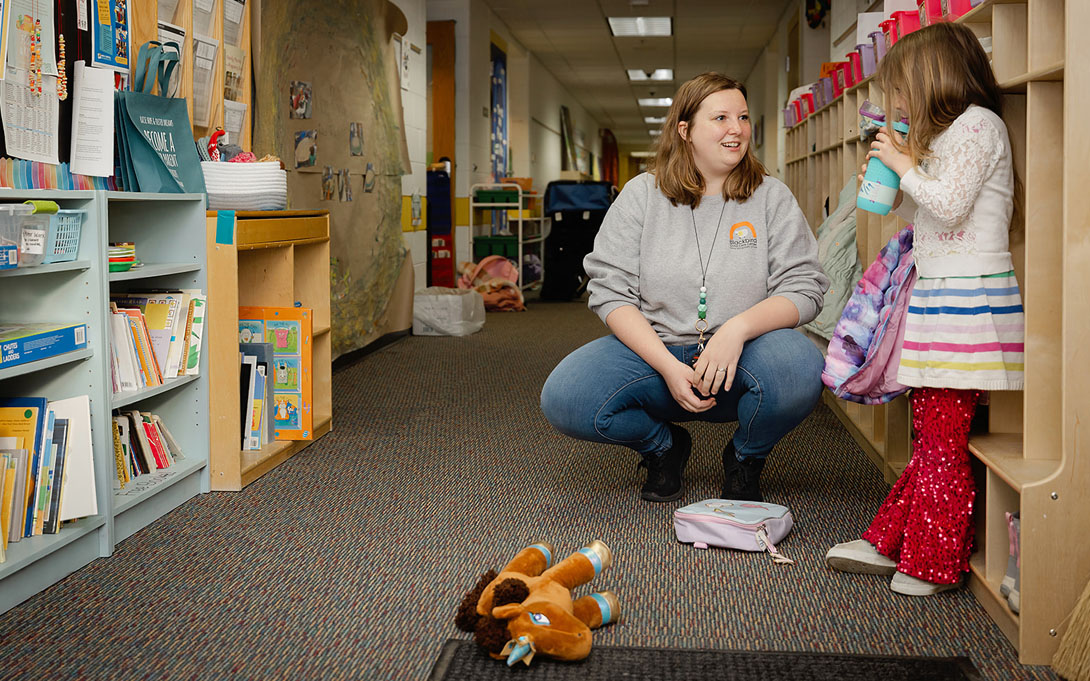
A teacher has a question, notes for families await delivery to classrooms, and a little girl arriving at Blackbird Child Care Center in Harbor Springs needs her rain boots swapped for shoes.
Sadie Riley-Flemming responds to it all with a smile.
“Are you leaving your unicorn in your cubby or are you taking it to your classroom?” Riley-Flemming asks the girl, kneeling beside her in the hallway lined with colorful kids’ artwork. “You can’t forget your water bottle. Let’s grab your lunch box.”

Riley-Flemming walks the girl down the hall and continues her morning rounds, popping between classrooms for infants up to 12 year olds. A cuddly toddler’s drool soaks into Riley-Flemming’s gray Blackbird sweatshirt as she greets kids with hugs and plays with them briefly while asking their teachers if they need anything. In one room, Riley-Flemming’s son offers her a tray of plastic food.
“Mommy, I got all the food on there for you,” he says.
All morning, Riley-Flemming shifts between her role as a mother to two kids under 5, director of Blackbird Child Care Center, and frontline child care worker. She has a unique vantage point on Michigan’s child care industry – and lately she finds it “overwhelming and heartbreaking.”

That gap Riley-Flemming identifies between what parents can afford to pay and the cost of quality child care is one of the key drivers of Michigan’s undersized child care workforce and shortage of available child care, according to research from North Central Michigan College’s Child Care Initiative and the University of Michigan’s Poverty Solutions.
Statewide, there are about four children under 12 for every available child care spot. A couple making Michigan’s median income will spend about 14% of their income on center-based care for an infant – double the 7% of household income considered affordable for child care by the U.S. Department of Health and Human Services.
NCMC’s Child Care Initiative began working with Poverty Solutions in 2021 to better understand child care needs in Emmet County, located along the Lake Michigan shoreline at the northern tip of Michigan’s mitten. Historically, child care has been an undervalued industry, but the pandemic – with its temporary closures of child care facilities – made clear just how essential these workers are. With the workforce still in flux post-pandemic, Michigan misses out on $2.88 billion annually in economic activity when working parents struggle to find child care, according to a report from the Michigan Chamber of Commerce.

As child care providers, parents, policymakers, and researchers wrestle with how to address Michigan’s child care shortage and make the business model work, Riley-Flemming sees child care workers – many of whom are parents too – getting caught in the middle.
Child care often takes up a large portion of a parent’s earnings, Riley-Flemming noted, even if child care workers get discounted tuition for their kids’ care.
“Then they’re also still not being paid a livable wage,” she said. “So they’re stuck in this middle ground where they might love working in the field, but they’re not really getting ahead, are they?”
Continue reading the story at U-M's Poverty Solutions.
By Lauren Slagter, U-M Poverty Solutions
Related
The Child Development and Care Subsidy: Challenges and Opportunities policy brief
North Central Michigan College Child Care Initiative
The Updated Michigan Child Development and Care Subsidy: What Child Care Providers Need to Know
